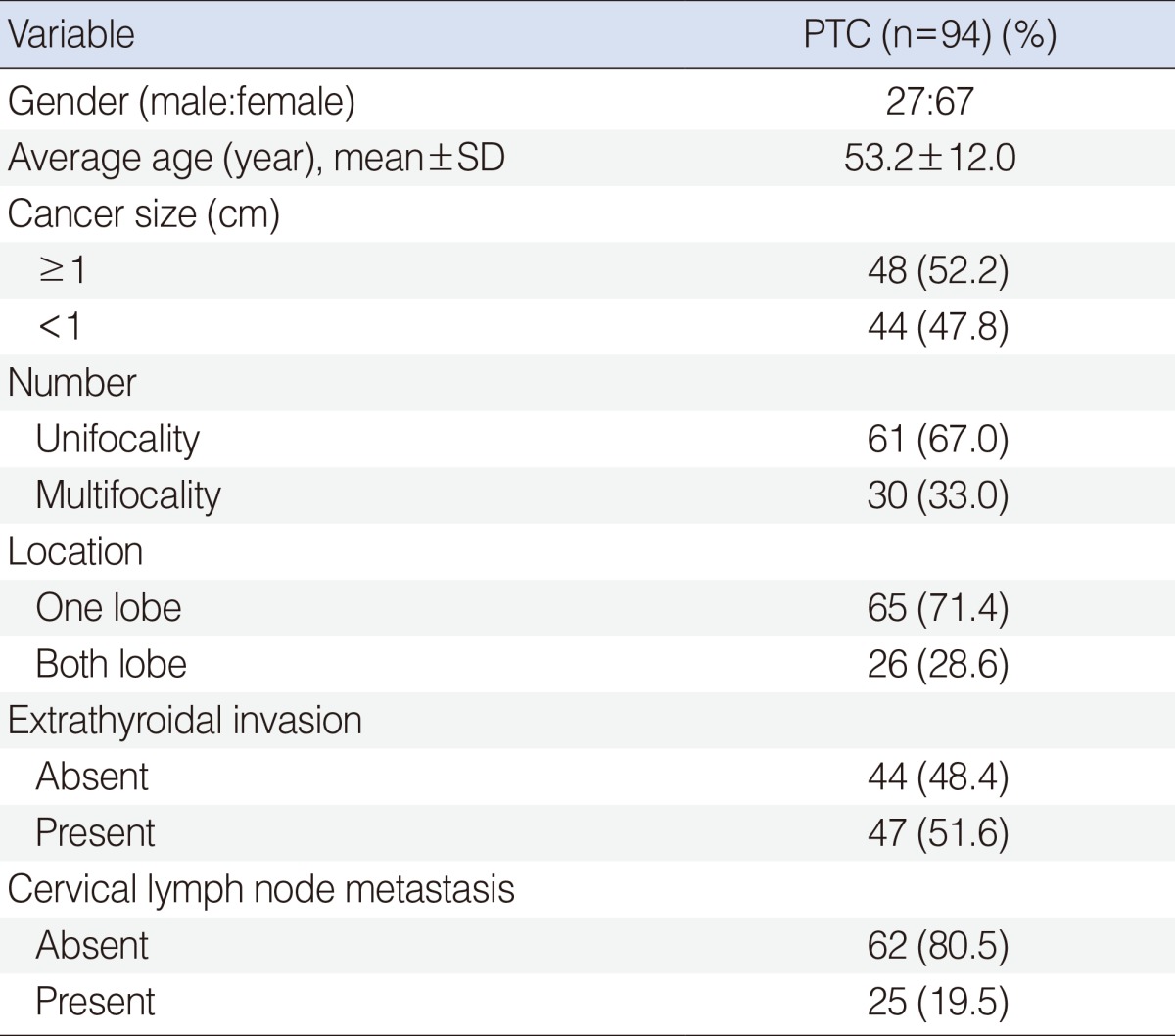2. Zitzelsberger H, Bauer V, Thomas G, Unger K. Molecular rearrangements in papillary thyroid carcinomas. Clin Chim Acta. 2010; 3. 411(5-6):301–308. PMID:
19958753.

3. Baverstock K, Egloff B, Pinchera A, Ruchti C, Williams D. Thyroid cancer after Chernobyl. Nature. 1992; 9. 359(6390):21–22. PMID:
1522880.

4. DeLellis RA. Pathology and genetics of thyroid carcinoma. J Surg Oncol. 2006; 12. 94(8):662–669. PMID:
17131411.
5. Czene K, Lichtenstein P, Hemminki K. Environmental and heritable causes of cancer among 9.6 million individuals in the Swedish Family-Cancer Database. Int J Cancer. 2002; 5. 99(2):260–266. PMID:
11979442.

6. Goldgar DE, Easton DF, Cannon-Albright LA, Skolnick MH. Systematic population-based assessment of cancer risk in first-degree relatives of cancer probands. J Natl Cancer Inst. 1994; 11. 86(21):1600–1608. PMID:
7932824.

7. Young MR, Colburn NH. Fra-1 a target for cancer prevention or intervention. Gene. 2006; 9. 379:1–11. PMID:
16784822.

8. Chiappetta G, Tallini G, De Biasio MC, Pentimalli F, de Nigris F, Losito S, et al. FRA-1 expression in hyperplastic and neoplastic thyroid diseases. Clin Cancer Res. 2000; 11. 6(11):4300–4306. PMID:
11106247.
9. Smith M, Burke Z, Humphries A, Wells T, Klein D, Carter D, et al. Tissue-specific transgenic knockdown of Fos-related antigen 2 (Fra-2) expression mediated by dominant negative Fra-2. Mol Cell Biol. 2001; 6. 21(11):3704–3713. PMID:
11340164.

10. Milde-Langosch K, Janke S, Wagner I, Schroder C, Streichert T, Bamberger AM, et al. Role of Fra-2 in breast cancer: influence on tumor cell invasion and motility. Breast Cancer Res Treat. 2008; 2. 107(3):337–347. PMID:
17393299.

11. Murakami M, Ui M, Iba H. Fra-2-positive autoregulatory loop triggered by mitogen-activated protein kinase (MAPK) and Fra-2 phosphorylation sites by MAPK. Cell Growth Differ. 1999; 5. 10(5):333–342. PMID:
10359014.
12. Bakiri L, Matsuo K, Wisniewska M, Wagner EF, Yaniv M. Promoter specificity and biological activity of tethered AP-1 dimers. Mol Cell Biol. 2002; 7. 22(13):4952–4964. PMID:
12052899.

13. Handkiewicz-Junak D, Czarniecka A, Jarzab B. Molecular prognostic markers in papillary and follicular thyroid cancer: current status and future directions. Mol Cell Endocrinol. 2010; 6. 322(1-2):8–28. PMID:
20138116.

14. Eun YG, Shin IH, Kim MJ, Chung JH, Song JY, Kwon KH. Associations between promoter polymorphism -106A/G of interleukin-11 receptor alpha and papillary thyroid cancer in Korean population. Surgery. 2012; 2. 151(2):323–329. PMID:
21982075.

15. Dardano A, Falzoni S, Caraccio N, Polini A, Tognini S, Solini A, et al. 1513A>C polymorphism in the P2X7 receptor gene in patients with papillary thyroid cancer: correlation with histological variants and clinical parameters. J Clin Endocrinol Metab. 2009; 2. 94(2):695–698. PMID:
19017759.

16. Ozgen AG, Karadeniz M, Erdogan M, Berdeli A, Saygili F, Yilmaz C. The (-174) G/C polymorphism in the interleukin-6 gene is associated with risk of papillary thyroid carcinoma in Turkish patients. J Endocrinol Invest. 2009; 6. 32(6):491–494. PMID:
19494710.

17. Erdogan M, Karadeniz M, Ozbek M, Ozgen AG, Berdeli A. Interleukin-10 gene polymorphism in patients with papillary thyroid cancer in Turkish population. J Endocrinol Invest. 2008; 9. 31(9):750–754. PMID:
18997484.

18. Siraj AK, Al-Rasheed M, Ibrahim M, Siddiqui K, Al-Dayel F, Al-Sanea O, et al. RAD52 polymorphisms contribute to the development of papillary thyroid cancer susceptibility in Middle Eastern population. J Endocrinol Invest. 2008; 10. 31(10):893–899. PMID:
19092295.

19. Rebai M, Kallel I, Charfeddine S, Hamza F, Guermazi F, Rebai A. Association of polymorphisms in estrogen and thyroid hormone receptors with thyroid cancer risk. J Recept Signal Transduct Res. 2009; 29(2):113–118. PMID:
19519176.





 PDF
PDF Citation
Citation Print
Print




 XML Download
XML Download